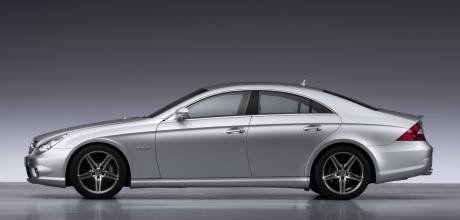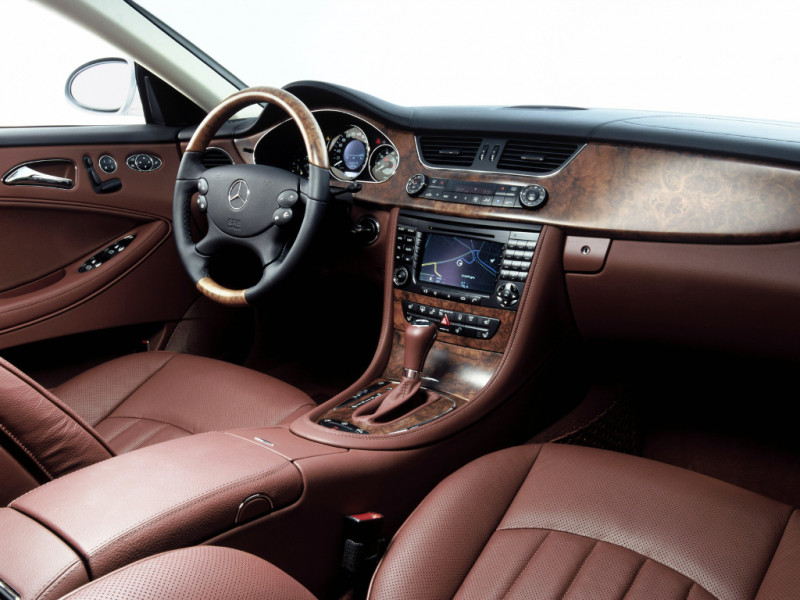Mercedes-Benz CLS C219

Mercedes-Benz’s original four-door coupe of 2004 was a big hit with buyers, bringing additional style and handling panache to the saloon car formula.
C219 CLS
WORDS DAVID SUTHERLAND
IMAGES TERRY OBORNE & MERCEDES-BENZ GROUP AG
The CLS felt a much more exclusive car than the E-Class on which it was based
As a model series switches from one generation to another, it’s not uncommon to see the original styling purity diluted or even lost, as the impossible task of improving on perfection is attempted. For many, this was seen not once, but twice in the case of the Mercedes-Benz CLS: first, when the lean, sharply drawn but elegant C219 gave way to the C218 with added flab, and second, on the arrival of the third and current C257 incorporating a noseful of challenging angles.
The CLS felt a much more exclusive car than the E-Class on which it was based
Such a process tends to engender increasing affection for the original, and that’s being seen with the 2004-launched CLS, clean examples being offered on classic car sales platforms at prices way above those of many other Mercedes of the same era. Born of Mercedes’ strategy to offer as many different models as possible in order to boost production volume, the CLS was unveiled at 2004’s Geneva motor show as a ‘four-door coupe’. The claim by the late Jürgen Hubbert, head of Mercedes cars at the time, that the design study, Vision CLS, was “a coupe generation ahead of the rest,” was at first widely assumed to be a market niche too far, but turned out to be one of Stuttgart’s smartest moves in years, as not only did it sell well and initiate a new bloodline that continues nearly two decades on, but prompted competitors to follow suit, most notably Porsche with its Panamera.

The CLS was launched in three petrol-engined forms: the 3.5-litre V6 CLS350, five-litre V8 CLS500 and 5.4-litre CLS55 AMG, with a diesel, the CLS320 CDI, following the year after. But the two models that topped and tailed the range, the Affalterbach powerhouse and the supersmooth diesel, also defined it, and in the process all but sidelined the other two. The timing for the CLS320 CDI could not have been better. The diesel market was growing and Mercedes, after decades of subjecting customers to slow and rattly oil burners, had just introduced by far its best ever take on Rudolf Diesel’s compression ignition invention, the three-litre OM642 V6.
A replacement for both the OM648 3.2-litre straight-six and OM612 2.7-litre five-cylinder engines, it used Mercedes’ third-generation ‘common-rail’ fuel injection, featured piezo injectors that operated much more quickly than the previously used solenoid valves and delivered more accurate fuel metering, and enjoyed a ‘variable nozzle turbine’ turbocharger and a more sophisticated electronic management system. It was light in weight too, thanks to an aluminium crankcase.
Its 221bhp and 376lb ft torque (later increased), fed to the rear wheels via the then recently introduced 7G-Tronic automatic transmission, gave the CLS320 CDI performance not far behind the CLS500 and fuel economy way ahead of the CLS350. It soon became the best-selling CLS. With a mild bodykit and 18-inch AMG alloy wheels, the CLS55 AMG was subtle on the surface, yet anything but under the bonnet. It used the 5.4-litre M113 V8 in supercharged form, the three-valver introduced in the late 1990s which for this application produced 469bhp, fed through Mercedes’ five-speed AMG Speedshift gearbox; the 516lb ft torque might have been too much for the 7G-Tronic ’box.
The Affalterbach CLS made for a glorious combination of massive power and torque, and velvet refinement, wrapped up in a body that was so much sleeker and more distinctive than the 211-series E-Class it was based on. The obvious question was whether the CLS, nearly two inches lower than the E-Class, could provide the dignified access that well-heeled owners expected in a four-door Mercedes. Thanks to clever packaging it did, with a bonus that inside the CLS felt a much more exclusive car than the E-Class, which was going through some well documented build quality problems.
Overall, that first CLS felt so right in every way. It looked cutting edge yet pretty, and offered a sublime driving experience, whether under diesel or supercharged petrol power. Had the catchphrase ‘Grace, space and pace’ not been Jaguar’s, it would have summed up the CLS.
The 219-series CLS was built until 2010, with a facelift two years before that. A key development occurred in 2006 when Mercedes concluded that the complex Sensotronic Brake Control (which via a series of sensors optimised braking effort) was a bad idea and replaced it with the Adaptive Brake system from the S-Class.
Also in that year, the CLS55 AMG became the CLS63 AMG and underwent a fundamental change in character due to the smooth and soft M113 being replaced by the fiery 6.2-litre, normally aspirated M156 V8, the first engine that AMG designed and built from scratch. Essentially a racing engine, it offered more power but less torque (507bhp/465lb ft) than the CLS55, and thrived on high revs, at which point it sounds magnificent. However, the M156 has proved less reliable than the M113, which many specialists regard as Mercedes’ most durable V8.
The German car industry likes a conservative, evolutionary approach to design, sticking to the rules to avoid alienating dear customers. But now and again, it tears up the rulebook to great effect, as in the case of the original Mercedes-Benz CLS.
White-faced dials another hint that the CLS was different.
Petrol V6 and V8s, and a V6 turbodiesel made up the range.
Supercharged four-cylinder of the SLK200 Kompressor.
AMG’s CLS55 with suspension and aero modifications. Headroom will be the only issue for those seated in the rear…
White-faced dials another hint that the CLS was different. Petrol V6 and V8s, and a V6 turbodiesel made up the range.
The cabin feels more special and luxurious than an E-Class’s. CLS blends sharp edges with gentle curves throughout.

